Reaching kids before spark explodes
August 3, 2011
In the summer of 2008, three teenaged boys climbed a hill with a half-dozen big firecrackers. It was July in Pasadena and the slope was tinder dry. Later, they would say that they weren’t thinking about fire hazards as one pulled out a cherry bomb and let another one light it—they just wanted “to make a lot of noise.”
In a backyard patio not far from the hillside, a neighbor heard an explosion and then saw flames rising. Next door, a 911 caller reported yelling and “high-fiving” as the boys ran away. The flames were out of control within minutes; they consumed five acres of the Angeles National Forest before firefighters stopped them. Two of the three juveniles were subsequently convicted of arson.
Though the harshness of the conviction was unusual, the incident wasn’t. According to the Burn Institute in San Diego, minors account for more than 50% of all arson arrests in the nation. A 2010 report for the National Fire Protection Association found that in the year of that Pasadena incident, children playing with fire started some 53,500 conflagrations, causing some $279 million in property damage, 70 civilian deaths and 910 injuries.
That’s why a modest $148,760 grant approved this week by the Board of Supervisors is being welcomed at the Los Angeles County Fire Department. Earmarked for a special program in intervention and one-on-one counseling of juvenile fire setters, it will increase by several orders of magnitude the number of county firefighters who are trained to deal with an ongoing hazard, particularly in fire-prone communities.
“It’s a program we’ve always had, but our ability to train firefighters in these skills has ebbed and flowed over the years,” says Chief Deputy John Tripp, who commands the department’s emergency operations. At the moment, Tripp says, the department has “maybe a dozen” firefighters who have received the special training necessary to intervene when a fire turns out to have been caused by a minor.
“That limited a number of people is of questionable effectiveness when you’re trying to protect 4 million people,” he says.
Administered by the Federal Emergency Management Agency and the U.S. Department of Homeland Security, the grant—which will be matched by a $37,190 contribution from the county—will allow the department to offer 32 hours of special training to 66 firefighters sometime early next year.
As Juvenile Fire Setter Intervention specialists, those firefighters will then be able to make the necessary assessments when a child starts a fire, bringing a child and his or her family in to the fire station for one-on-one counseling and education or, in more serious cases, referring the child for more extensive professional treatment.
Most fires are accidental, Tripp says, and fires started by children are usually the result of “naïveté about the danger.” But playing with fire can also be a sign of psychological problems.
“The statistics show that without intervention, a lot of juvenile fire-setters will start fires again,” says Heidi Oliva, a civilian administrative services manager for the department who helped shepherd the grant.
Oliva has firsthand experience with the risks of juvenile fire setters. In October, 2007, she and her husband had to flee their Santa Clarita home with a 4-year-old and an infant when stiff Santa Ana winds swept the Buckweed Fire down from Agua Dulce. The fire destroyed 38,000 acres and 21 homes.
Its cause? A 10-year-old child playing with a pack of matches. The child eventually moved and prosecutors chose not to file charges; authorities must prove intent to cause harm in order to charge someone with arson, and that can be difficult with young children.
But the lessons of that fire and others are instructive, Tripp says.
“Fire is a natural foe and a danger to everyone in our community all the time, and if we can step in at the start of a dangerous behavior, we need to do that. Otherwise, a small situation can become a larger, more dangerous one.”
Posted 8/3/11
Give their regards to Broadway
August 3, 2011
The Walt Disney Concert Hall is alive with The Sound of Music–and other musical gems of the stage and concert hall—in a special Saturday matinee concert by the California Philharmonic.
Works by Rodgers and Hammerstein will be featured, including songs from hit musicals Oklahoma!, South Pacific and The Sound of Music. Also on the menu is the William Tell Overture, Tchaikovsky’s Romeo and Juliet, and the symphonic poem The Sorcerer’s Apprentice, famously included in Walt Disney’s classic animated film, Fantasia.
This concert is part of maestro Victor Vener’s “That’s Entertainment” series, which expands the symphonic repertoire to include the best of jazz, pop, Broadway and opera. Joining in this Saturday will be Broadway vocalists Brandi Burkhardt and Derek Keeling, whose roles have included parts in hit musicals Mamma Mia! and Grease, respectively.
The show starts at 2 p.m. on Sunday, August 7. The Walt Disney Concert Hall is located at 111 South Grand Avenue, just a block away from the Civic Center stop on Metro’s Red Line. Tickets start at $38 and may be purchased by through Ticketmaster at (800) 745-3000.
Posted 8/3/11
Shakespeare, shades and SPF
August 3, 2011
Shakespeare spends his summer all over the place: in the park, in the woods, in the amphitheater and yes, even on the beach. The folks at Santa Monica Rep are resident artists at the Annenberg Community Beach House this summer, and they are staging The Tempest in an outdoor production that’s free and open to the public. (Reserved seats are no longer available, but there are plenty of other ways to see the show; more about that later.)
Producing a play at the beach brings unique challenges, according to Eric and Jen Bloom, the husband-and-wife co-founders of Santa Monica Rep, along with Sarah Gurfield.
“There is not a whole lot of protection from the sun,” Eric said. “We are still debating whether or not to use sunglasses for the performance, but that might take away from the connection with the audiences.”
They also have noise to contend with. There is the ocean, for starters, and occasionally they have to “freeze” during scenes to let a helicopter pass. Luckily, the Southern California weather has been cooperative so far, raining out only one of the rehearsals.
When the Beach House first considered adding theatre to its public programming, there was uncertainty about how audiences would respond, said cultural affairs coordinator Naomi Okuyama. Last year they tested the waters by inviting a drama troupe. The outdoor shows were popular among beachgoers and theatre fans alike, so this year they took it up a notch, granting Santa Monica Rep an official residency. To ensure maximum community involvement, outdoor public rehearsals are a part of the contract.
Jen Bloom said she takes inspiration on how to attract beach wanderers from her day job at the Natural History Museum. There, she is tasked with engaging museum-goers of all ages for 35 theatrical performances a week.
“Rehearsing in the open, our actors engage more with the public,” she said. “I wanted to try that idea with Shakespeare. Our actors approach the audience, and the audience approaches them. It has really generated a lot of interest in the process.”
She also uses enormous, three-story “puppets,” created by volunteers and artists at a public workshop, that dangle from the facility’s guest house.
If nothing else, the juxtaposition of costumed actors against the beach scene should provide quite the spectacle. (Imagine actors, wearing Elizabethan garb made of recycled materials, sharing the space with bikini-clad skateboarders.)
Even though online reservations are no longer being taken, there will be some seats available to those who have signed up on the waiting list via the website, along with standing room and any seats left available by no-shows. Or check out one of the rehearsals, which take place from 4 p.m. to 10 p.m. this Thursday and Friday; 10 a.m. to 4 p.m. Saturday; and 10 a.m. to 7 p.m. Sunday. There also will be a full dress rehearsal on Tuesday, August 9, at 5 p.m.
The final product will be staged August 10-12 at 4:30 p.m. and August 13-14 at 2 p.m. and 4:30 p.m. The Annenberg Community Beach House, operated by the City of Santa Monica, is located at 415 Pacific Coast Highway. Don’t forget to bring hats and sunscreen. The Bard would have wanted it that way.
Posted 8/3/11
Happy trails with hiking safety tips
August 3, 2011
Baxter, the hiking dog, captured headlines last weekend with his now world-famous airlift from a San Dimas-area trail. But he and his owners were far from the only nature lovers who’ve needed a rescue this summer.
During the last week of July, local search and rescue workers came to the aid of an injured climber in one area near Malibu and a lost hiker in another. Near the Angeles National Forest, they pulled a 77-year-old man from a ravine and a fallen hiker from a pool at the base of a rock pile. They helped find a day-tripper who had gone missing near Topanga Canyon. And that’s not including the two motorists who had to be plucked from the Santa Monica Mountains after their vehicles careened into canyons, or the diving accident off Santa Catalina Island.
“It was a fairly normal week,” says Los Angeles County Sheriff’s Sgt. Jack Ewell of the department’s Special Enforcement Bureau, which coordinates an estimated 350 search and rescue missions a year in Los Angeles County. “You have to remember, the county is about 4,000 square miles, and the weather has been nice.”
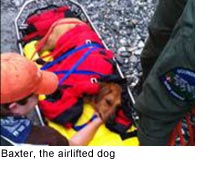 Thousands safely and happily take advantage of Los Angeles’ wilderness areas without incident year-round. Nonetheless, L.A. County remains one of the nation’s most active search-and-rescue hotspots, and this summer’s almost daily demand offers a sobering reminder of the need for hikers to take precautions when they head for the great outdoors.
Thousands safely and happily take advantage of Los Angeles’ wilderness areas without incident year-round. Nonetheless, L.A. County remains one of the nation’s most active search-and-rescue hotspots, and this summer’s almost daily demand offers a sobering reminder of the need for hikers to take precautions when they head for the great outdoors.
Ewell and others urge hikers to add just a couple of small steps to their preparations. Just a little bit of planning can make a big difference in the event that something happens to go wrong.
For example, one of the most valuable tips is now also one of the easiest to follow, thanks to a new online hiking plan form created by the Los Angeles County Sheriff’s Department. (Download one here.)
The form allows you to create a list of all the vital information about your hiking party, your proposed campsites and hiking route, your planned start and return dates and what vehicles and supplies you’ll have with you. You can augment it, if you like, with a photograph of the bottom of your hiking boots, so that if you get lost, trackers can more easily find you.
“If something happens, this gives us the information we need to go in and assist you,” says Ewell. “Just leave it with a friend or relative.”
Another bit of advice hikers ignore at their peril? Bring the right stuff. Remember that you’re going into the wilderness.
“Don’t go hiking in flip flops,” Ewell says. “Bring water and a GPS and a cell phone. Check the forecast. It might be a hundred degrees when you leave the house, but it can get down to 30 degrees in some places at night.” The National Park Service offers more of these kinds of useful tips.
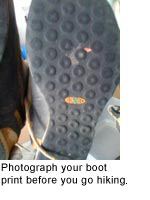 If you’re thinking about backpacking or camping, get the right vaccinations and practice fire and water safety. The Centers for Disease Control and Prevention has a comprehensive checklist here.
If you’re thinking about backpacking or camping, get the right vaccinations and practice fire and water safety. The Centers for Disease Control and Prevention has a comprehensive checklist here.
Finally, don’t end up like the couple who made headlines last weekend when their 80-pound Labrador mix, Baxter, couldn’t handle the rocky terrain on the Bridge To Nowhere Trail in the Angeles National Forest and had to be airlifted to safety.
Think twice before you take your pets hiking. Los Angeles has plenty of open space for animals and people to share, and some areas, such as Griffith Park, are safe for well-trained pets. However, pet access is fairly limited in the state and national park systems, and many wild areas are unsafe for Fido and Fifi.
If you insist on hitting the trail with an animal companion, do look out for your best friend—bring extra water, check his or her foot pads often and keep an eye out for porcupines, skunks and other hazards.
For more tips on hiking with pets, click here and here. Or follow Ewell’s advice: “Unless it’s a very easy hike, I really wouldn’t bring your pet with you at all.”
Posted 8/3/11
A lonelier ride on Dodgers Express
August 3, 2011
You know the Dodgers are having a tough year when even the free bus service to the stadium is in a slump.
Ridership on the Dodger Stadium Express, which whisks ticketholders free of charge from Union Station to the stadium in clean-burning, natural gas-powered buses, dropped 19% in June and July. Passengers took 37,526 rides to and from the stadium on the Express during that period, compared to 46,337 rides during the same months last year.
On 16 occasions so far this year, regular season ridership on the dedicated fleet of buses has dipped below 1,000, hitting a low of 678 on Monday, July 25, when the Dodgers beat the Rockies 8-5. Last year, regular season ridership on the Express buses went below 1,000 just seven times. Overall, ridership this year to date stands at 81,518, compared to 82,222 at this time last year.
Metro launched the Express service’s rookie season last year with a $300,000 grant from the Mobile Source Air Pollution Reduction Review Committee (MSRC.) A $450,000 grant brought the buses back this year, along with some new post-game Metrolink train service, amid high hopes that the team and its fans would have a season worth celebrating.
It was not to be. The opening day beating of Bryan Stow, along with the team owners’ well-publicized divorce, bankruptcy filing and a dispiriting string of player injuries, set the tone for a dismal season in which attendance has plummeted and the Dodgers are struggling in the lowest rungs of their division. This week, a posting on The Los Angeles Times’ Dodgers blog carried the headline: “It’s official: The worst Dodgers season ever.”
Ridership was so low on Metrolink’s special post-game night trains that the agency recently cancelled the service to the Antelope Valley and Ventura County—although 11 p.m. trains to San Bernardino are continuing as part of the regular schedule.
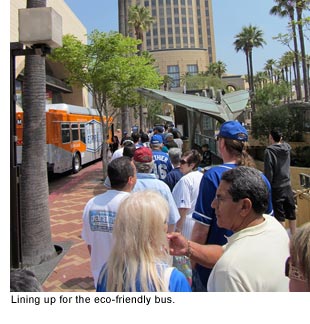 Yet there’s still hope that the Dodgers Express bus service—though possibly not the Dodgers themselves—will end up the season with the same or slightly better stats than last year. The National League East-leading Phillies are in town next week, and a half-price food-and-drink promotion will be in place for the 12:10 p.m. game on Wednesday, Aug. 10. Another bargain food-and-drink promotion is scheduled for Aug. 31, when the Dodgers play the Padres at 12:10 p.m. (The half-price deal doesn’t apply to alcoholic beverages—a policy change enacted after the Stow beating.)
Yet there’s still hope that the Dodgers Express bus service—though possibly not the Dodgers themselves—will end up the season with the same or slightly better stats than last year. The National League East-leading Phillies are in town next week, and a half-price food-and-drink promotion will be in place for the 12:10 p.m. game on Wednesday, Aug. 10. Another bargain food-and-drink promotion is scheduled for Aug. 31, when the Dodgers play the Padres at 12:10 p.m. (The half-price deal doesn’t apply to alcoholic beverages—a policy change enacted after the Stow beating.)
Both promos are expected to boost ridership and perhaps put the Express on track to equal or even slightly exceed last year’s totals, said Elizabeth Carter, Metro transportation contract services manager. (A Duke Snider bobblehead giveaway on Aug. 9 couldn’t hurt.)
“What really hurt our ridership this year was that incident that happened on opening day,” she said, noting that the economy and public perceptions about the McCourts’ divorce also played a role.
Still, if ridership ends up matching last year’s, that will represent a significant contribution to better air quality in the region. Ray Gorski, technical advisor to the MSRC, said that 77,000 car trips and 1.37 million travel miles were eliminated by virtue of the Dodgers Express service last year.
“I think we still consider the service a success,” said Conan Cheung, Metro’s deputy executive director of service development. He pointed out that, given lower Dodgers attendance levels this year, Express ridership may actually end up representing a higher proportion of fans opting to take the bus.
Those who choose the Express get the good feeling that comes from choosing the environmentally-friendly option, as well as a good deal: a free ride for ticketholders, $1.50 each way for those without.
“We’re getting a lot of compliments,” Carter said. “We get a lot of dedicated riders. They leave the driving to other people, and they don’t have to deal with the traffic.”
Posted 8/3/11
A Tony-studded “Hairspray” at the Bowl
August 1, 2011

If you missed Harvey Fierstein’s Tony-winning turn as Edna Turnblad in “Hairspray” on Broadway, cheer up. He’s strapping on the padding again this weekend at the Hollywood Bowl.
Fierstein, who won the Tony in the role, reunites with Marissa Jaret Winokur, also honored with a Tony for her portrayal of Tracy Turnblad. Joining them in the Bowl production are such notables as Drew Carey, John Stamos, and Nick Jonas (of The Jonas Brothers), among others.
Hairspray is based on the 1988 comedy by John Waters, master of the bizarre cult film. The story is set in Baltimore amid the doo-wop and beehive hairdos of the early 1960s. A chubby teen defies the odds and becomes famous on a local dance show, then embarks on a mission of racial integration against jealous and bitter rivals. The film was a crossover success for Waters, whose earlier flicks found success primarily among independent film aficionados and the counterculture.
The musical is directed and choreographed by Jerry Mitchell. Performances start at 8:30 p.m. on Friday and Saturday, August 5 and 6, and at 7:30 p.m. on Sunday, August 7. Tickets range from $16 to $168, and are available online, by calling (323) 580-2000, or in person at the box office. The Hollywood Bowl is located at 2301 North Highland Avenue. Parking starts at $16 and is very limited, so get there using the Bowl Shuttle, Park & Ride, or Metro.
Posted 8/1/11




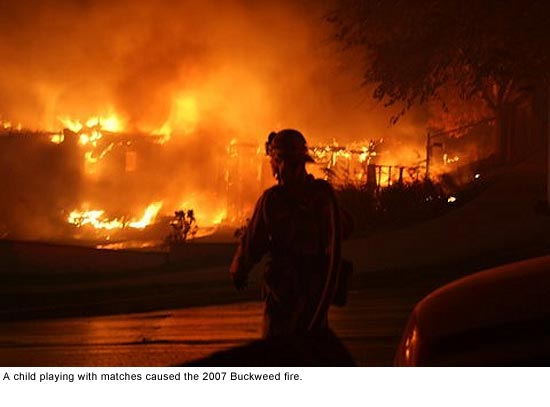
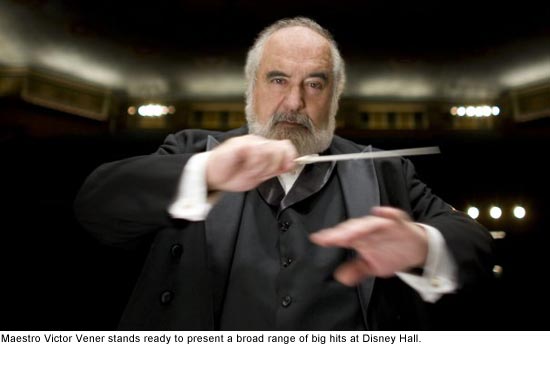
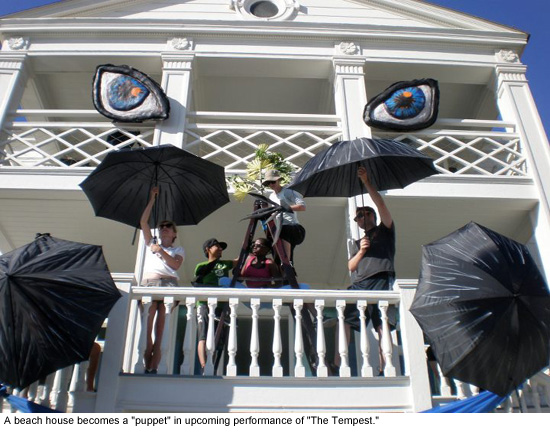
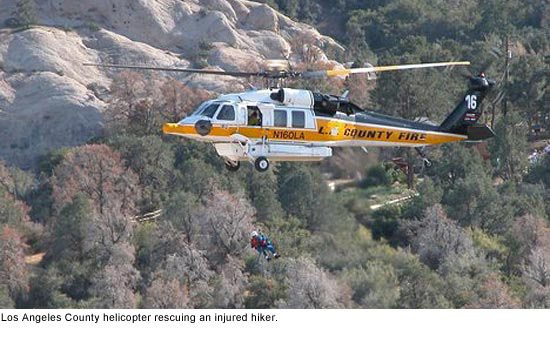






 Check for the latest closure information
Check for the latest closure information








